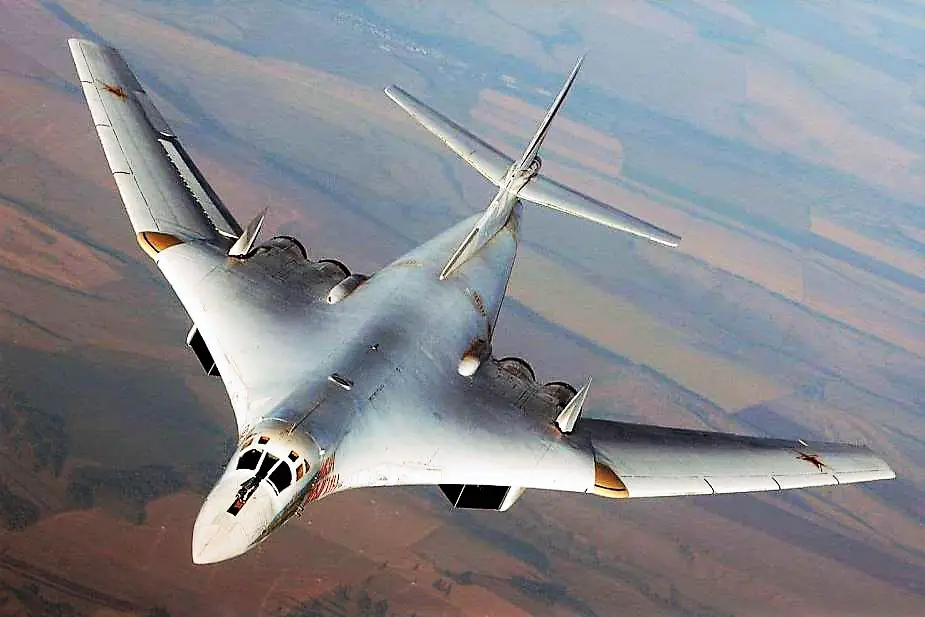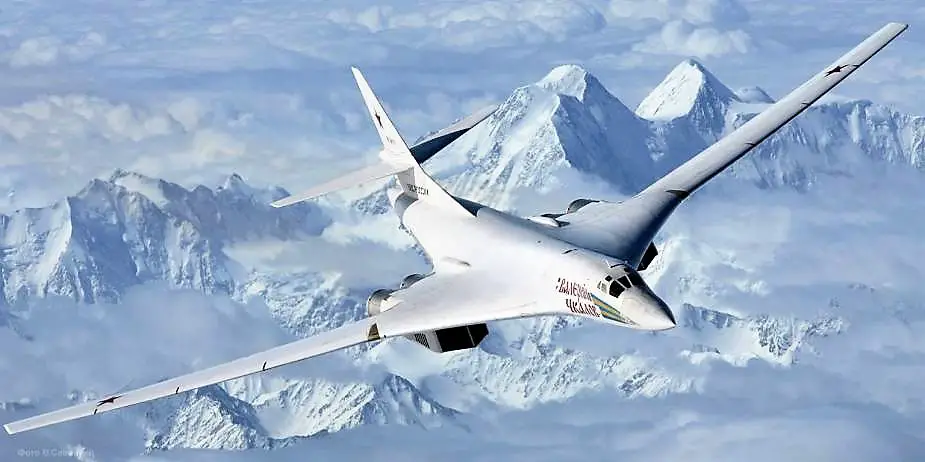Another upgraded Tupolev Tu-160M strategic bomber made the maiden flight, the United Aircraft Corporation (UAC) said on December 20: “In December 2022, another upgraded Tu-160M strategic bomber designed by the Tupolev Bureau made the first flight,” it said. The pilots maneuvered to test the stability and controllability of the aircraft, as well as systems and engines and electronic equipment.
Follow Air Recognition on Google News at this link
 The Tupolev Tu-160 Blackjack is a supersonic, variable-sweep wing heavy strategic bomber designed in the 1970s. It is the largest and heaviest supersonic military aircraft ever built and second to the experimental XB-70 Valkyrie in overall length (Picture source: Russian Air Force)
The Tupolev Tu-160 Blackjack is a supersonic, variable-sweep wing heavy strategic bomber designed in the 1970s. It is the largest and heaviest supersonic military aircraft ever built and second to the experimental XB-70 Valkyrie in overall length (Picture source: Russian Air Force)
Tu-160 strategic bomber (Blackjack by NATO classification) is designed to strike at important facilities with long-range cruise missiles. It can carry 24 missiles. The total payload is 45 tons. The bomber has a variable-sweep wing of the integral low-wing scheme. Maximum takeoff weight is 275 tons, the length is 54.1 meters. The cruising speed is 850 km/h, and the maximum speed is 1,800 km/h. The practical ceiling is 15,000 meters. The bomber has four turbojet double-flow engines NK-32 with a boost chamber.
The Tupolev Tu-160 is a supersonic, variable-sweep wing heavy strategic bomber designed in the 1970s. It is the largest and heaviest supersonic military aircraft ever built and second to the experimental XB-70 Valkyrie in overall length. As of 2022, it is the largest and heaviest combat aircraft, the fastest bomber in use, and the largest and heaviest variable-sweep wing airplane ever flown.
Entering service in 1987, the Tu-160 was the last strategic bomber designed for the Soviet Union. As of 2016, the Russian Air Force's Long Range Aviation branch had 16 aircraft in service. The Tu-160 active fleet has been undergoing upgrades to electronics systems since the early 2000s. The Tu-160M modernization program of existing models has begun with the first updated aircraft delivered in December 2014. In January 2022 the first serial-built aircraft had its test flight, with two planned for delivery in 2022 from 10 on order. Plans include 50 new Tu-160M bombers and upgrading 16 existing aircraft, a programme that is ongoing.
Modernization of existing models
The first overhauled and partially modernized aircraft was accepted into Russian service after testing in July 2006. The aircraft reportedly received the capability to use conventional weapons but was not upgraded with new avionics as previously planned. The first modernized aircraft capable of carrying the new long-range Kh-555 conventional cruise missile was delivered to the Russian Air Force in April 2008; a follow-up contract for the modernization of three more aircraft is estimated to cost RUR3.4 billion (US$103 million).
The modernization appeared to be split into two phases, first concentrating on life extension with some initial communication–navigation updates, followed by engine upgrades after 2016. In November 2014, a Tu-160 upgraded with new radar and avionics performed its first flight. The aircraft was delivered to the Russian Air Force as the Tu-160M model in December 2014. The phase I update was due to be completed by 2016, but industrial limitations may delay it to 2019 or beyond. Although Kuznetsov designed an NK-32M engine with improved reliability over the NK-32 engines, its successor company has struggled to deliver working units. Metallist-Samara JSC had not produced new engines for a decade when it was given a contract in 2011 to overhaul 26 of the existing engines, by two years later, only four were finished. Ownership and financial concerns hinder the prospects of a new production line; the firm insists it needs a minimum of 20 engines ordered per year but the government is only prepared to pay for 4–6 engines per year. A further improved engine has been bench tested and may enter production in 2016 or later. Deliveries started in 2020 and 5 aircraft have been equipped with the new engines as of August 2022.
New modernized in production
On 29 April 2015, Russian Defense Minister Sergei Shoigu, on the order of President Putin, announced that Russia was resuming production of the Tu-160. In May 2015, TASS reported that the Russian Air Force would purchase at least 50 newly built Tu-160s and that the production of the aircraft would resume at KAPO. General Viktor Bondarev has said that the development of the PAK DA will continue alongside the resumption of production of the older model bomber.
On 16 November 2017, a newly assembled Tu-160, built from an unfinished Tu-160 airframe, was unveiled during a roll-out ceremony at KAPO, signifying a restoration of certain production technologies such as electron-beam welding or titanium work reportedly lost after the termination of serial production in 1992. According to Dmitri Rogozin, the serial production of completely new airframes for the modernized Tu-160M2 should begin in 2019 with deliveries to the Russian Air Force in 2023. The aircraft, named Petr Deinekin, after the first commanding officer of the Russian Air Force Gen. Pyotr Deynekin, performed its maiden flight in January 2018 and began flight testing the same month. It performed its first public flight on 25 January 2018, during President Vladimir Putin's visit to KAPO plant. The same day, a contract for ten upgraded Tu-160M2 bombers was signed. On 12 January 2022, a new serial produced from scratch Tu-160M had its first low-altitude basic test flight. It is planned to deliver 2 newly built serial Tu-160M before the and of 2022 with ramping up production until all 50 on-order new aircraft are delivered.
 T
T
Plans include 50 new Tu-160M bombers and upgrading 16 existing aircraft, a programme that is ongoing (Picture source: Russian Air Force)
















